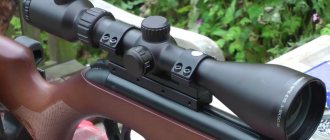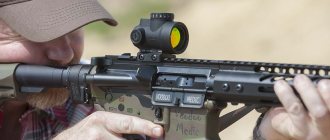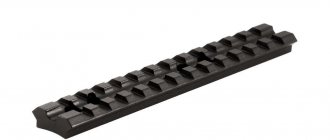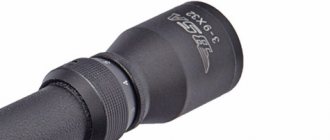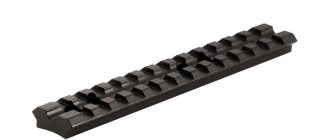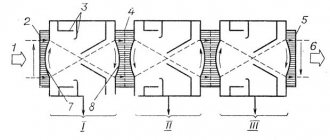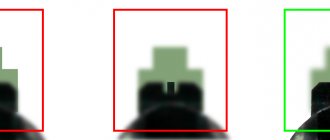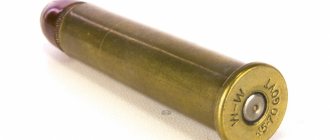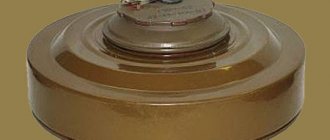How do you begin zeroing an optical sight on a carbine? Before you begin, you need to make sure that the weapon is well suited for mounting the scope, and install it. Guns with Picatinny or Weaver rails are best; It is this type of mount that allows you to adjust it most quickly, and this setting lasts for a long time, nothing gets lost from the vibrations accompanying the shot.
Adjustment with a different type of fastening will take longer, and everything will go astray faster. Therefore, it is the mounting on Picatinny and Weaver rails that is now a generally recognized world standard.
Sight on SKS. Difficulties and solutions
Created by S.G. Simonov back in 1945, a self-loading carbine with the short name SKS is still used to this day. Hunters have many disagreements regarding SKS, but everyone is unanimous regarding the main advantage - a favorable price. The fact is that more than 15 million units of these weapons have been produced in the world. Despite the fact that the Simonov carbine had high shooting accuracy at medium and long shooting distances, it gave way to the AK - the Kalashnikov assault rifle, which, although less accurate, has a higher fire density and better suits modern combat tactics. The SKS was adopted by the USSR in 1945, but already in 1950 a decision was made to rearm and replace it with AK assault rifles, which was completed only by the end of the 1980s. Thus, in military warehouses in Russia there is a huge number of SKS carbines, which are slightly upgraded to a civilian model and are regularly released onto the market, which leads to the extremely low cost of these weapons.
Due to its wide availability (the first mass-produced civilian semi-automatic carbine) and high accuracy, the SKS is often used in commercial hunting. That is why the question of an optical sight for the SKS carbine is open. You need to select a sight taking into account the characteristics of the weapon.
First, let's look at the main civilian versions of the SCS:
- OP SCS
- "Arhar" (TOZ-97)
- KO SKS
- MP 163
- Lancaster series (SKS-366 and VPO-208)
For all types of designs, a problem often arises - optical sight on the SKS, which is better? The selection of a scope should begin taking into account two important factors - the presence or absence of a side mount and a vertical cartridge ejection system. Hunters often come to us with these problems.
The optical sight for the SKS must match the characteristics of the carbine. The 7.62x39 mm cartridge used on the SKS is designed for medium distances, since a direct shot from a carbine is about 350 meters. But still, in practice, firing distances are significantly lower - 100...150 meters. Such a cartridge also imposes a limitation - only on a medium-sized animal (after all, it was designed for a person weighing 80 kg), but for hunting they use an expansive design of the bullet, and there is still debate among hunters about this. Based on the shooting distance and the size of the game, the magnification of the optical sight is selected. When determining the required magnification, on the one hand, you need to take into account the size of the target, but if you use a higher magnification, a problem with hand sway arises. Sights with 4-6x magnification are quite suitable for SKS. As for the diameter of the sight, the aperture ratio will depend on the size of the lens. For hunting at dusk or in dense forest, choose a scope with a diameter of at least 40 mm. For normal daylight use, scopes smaller than 40mm in diameter are suitable. Well, at night, we recommend that you think about buying an inexpensive night vision scope.
Moreover, hunters often take compact scopes because the SKS has a problem with cartridge ejection. The cartridges fly up, causing them to hit the scope. To solve the problem, many hunters choose sights made of durable alloy or try to install it before the ejection cutout, which determines the use of compact sights taking into account eye relief. There is another solution - installing an adapter bracket from the side mount to the top universal Weaver bar. Such a bracket will take the load on itself and protect the scope from shell casings falling into it. Some hunters successfully use a homemade screen - made of leather or plastic - to protect their sights from shell casings.
Re-preservation procedure
Before you start shooting a newly purchased rifle, it is necessary to re-preserve the weapon, since factory rifles are generously lubricated with oil. To do this, follow the algorithm of actions described below.
- We carry out a complete disassembly of the weapon.
- We remove the shock-spring mechanism from the rifle.
- We get rid of the conservation grease.
- We clean all elements of the compressor system.
During re-preservation it is necessary to use only high-quality compounds and solvents. Of course, such a procedure is not strictly necessary, but it allows you to achieve better performance during zeroing.
2.1. Creating a seat. Side mounts
In various versions of the SKS, there may be no side strip. To install the sight, you need to create a seat. To solve this problem, side bars from the ECT manufacturer are available for sale in two versions:
More information about the bar: “SKS” bar
The strap is installed on the side of the receiver. This option is called “top position”.
More information about the plank: Plank “SKS-K”
The bar is an analogue of the “Hammer”. It is also attached to the side of the receiver, but the seat is located lower on the wooden fore-end. The type of fastening refers to the “bottom position of the bar”.
Factory made planks. Modern SKS are supplied with a “bottom” position installed (pictured on the left), old-style carbines have a “top” position (pictured on the right).
The TsKB Tochpribor design bureau produces similar strips for SKS and OP SK. The position of planks No. 6 and No. 7 refers to the “bottom position”. The difference between the Novosibirsk strips (No. 6 and No. 7) from the Tula “SKS-K” is associated with the place of attachment. The base of straps No. 6 and No. 7 has an additional protrusion designed for the thickness of the wooden fore-end; during installation, a rectangular groove is selected and the strap is seated on a metal base, unlike SKS-K, where the strap is screwed into the wood.
| Photo | |||
| Title and link to detailed information | Plank No. 6 | Plank No. 7 | Plank "SKS-K" |
| (Novosibirsk city) | "Tochpribor" (Novosibirsk) | "EST" (Tula) | |
| Required for installation | 4 screws, 4 holes in metal, cutting a rectangular groove in wood | 4 screws, 4 holes in metal, cutting a rectangular groove in wood | 2 rivets, 2 holes in metal, 2 holes in wood, 2 bolts, 2 screws |
| Stiffness | from the butt side | from the trunk side | from the trunk side |
The strips presented above are intended to create space for side fastening. The outfitter approached the issue of the lack of a bar a little differently:
More details about the bracket: Side bracket “Gyurza” Weaver for SKS, Arkhar (KS-TsF1)
The bracket is a permanent side bracket with a Weaver bar. Installation is carried out by mounting on the receiver without the possibility of dismantling. Such a bracket is specifically designed to withstand the mechanical impact of sleeves, while creating a universal mounting location for any type of optical instrument.
The “Gyurza” Weaver side bracket for the SKS is the best option for mounting a sight on the SKS-366 Lancaster : despite the strong recoil of the .366 TKM cartridge, thanks to the reliable non-removable mount with the receiver, you can install powerful optical sights on it, which will be additionally protected from sleeves
Laser zeroing sequence
During this process, the hunter is guided not by the bullet mark, but by the spot from the laser sight. To make precise adjustments, you must perform several sequential steps:
- We install the laser on the weapon and secure it to the machine.
- We turn on the boron siter and install it in the rifle barrel, as described in the instructions for your product.
- We look for a spot on the target and align the sight adjustment with it using a special mechanism.
- We fix the position of the optical sight dials.
After this, all that remains is to dismantle the drill siter and make a test shot to ensure the accuracy of the adjustment.
2.2. Creating a seat. Mounting through the receiver
SCS has a long history. Rare guns are often tuned to modern standards. The Lepers company, which also produces brackets for tuning weapons, manufactured receiver covers with a Weaver rail or 25.4 mm rings already installed:
UTG bracket MNT-T642 Weaver base for SKS Bracket Leapers MNT-T640 SKS receiver cover with rings 25.4
Due to the increased impact of recoil on the receiver, OpticsTrade recommends installing lightweight red dot or optical sights on this mount. The options will be presented below.
What will you need for work?
Before starting work, the master needs to acquire the following tools:
- Abrasive paste.
- Lapping rod. Its diameter must correspond to the diameter of the optical sight channel.
- Rod for controlling the alignment of rings.
- Torque wrenches equipped with a scale.
- Torque screwdriver.
The main task of lapping is to achieve alignment of the brackets: the centers of their rings must be located on the same axis.
Using side ring brackets
After creating the mounting location, we came to the question “how to install the sight on the SKS?” The carabiner has, as we found out above, two positions of the strap. With the upper position of the bar, the height of the brackets will be small; they are more similar to the brackets on the Tiger. Taking this into account, many manufacturers also add SKS to the brackets for the Tiger. But it is better to use ECT brackets specially designed for this height:
| If your bar has the following appearance (“high” location): | Choose the following bracket: | Brief description of the bracket: |
| Bracket KS (25.4) is designed for mounting sights with a mounting diameter of 25.4 mm | ||
| Bracket KS (30) is designed for mounting sights with a mounting diameter of 30 mm | ||
| The Weaver-SKS bracket is designed to create a Weaver rail (for example, for installing red dot sights) | ||
| Weaver bracket for SKS Alekat 100 mm Weaver bracket for SKS Alekat 140 mm Belarusian versions of adapter brackets with a quick-release clamp for the Weaver bar. Versions with strip lengths of 100 and 140 mm |
For the lower position of the bar, brackets for Saiga and Vepr are more suitable. There is more choice for such a mount; this will help you select scopes with different lens diameters and the ability to use an open sight.
| If your bar has the following appearance (“low” location): | Choose the following bracket: | Brief description of the bracket: |
| Bracket KT (25.4) is designed for mounting sights with a mounting diameter of 25.4 mm | ||
| Bracket KT (30) is designed for mounting sights with a mounting diameter of 30 mm | ||
| Bracket SB-W (25.4) is designed for mounting sights with a mounting diameter of 25.4 mm | ||
| Bracket SB-W (30) is designed for mounting sights with a mounting diameter of 30 mm |
Pay attention to the design of the side bar. The seat of planks No. 7 and “SKS-K” has a longitudinal groove that ends with a stopper. This is a tiger type of plank. The bracket also has a stopper that fits through the gutter when installed. The eye relief of the sight depends on the position of the bracket on the SKS. If you use a Vepr-type bracket, in which the stopper is located on the opposite side, you can achieve a closer position of the sight relative to the eye. A similar method is used in the SKS bracket from TsKB “TochPribor”:
More details about the bracket: SKS bracket (Tochpribor)
It is worth noting that this bracket is equipped with strap No. 6, thereby creating an additional pull towards the shooter’s eye. The bottom has a quick release latch. Available for both 25.4 and 30 mm rings.
To solve the problem of creating a universal Weaver rail on the SKS, we recommend the brackets listed below, which are selected primarily according to the mounting height of the sight. This rail allows you to use any sights with the help of stand rings, but is ideal for red dot sights with a Weaver-type monolithic bracket.
More details about the bracket: Bracket ВIII-2в
A small bracket made of aluminum is best suited for mounting red dot sights. Has a quick release lever mechanism.
More details about the bracket: Bracket UTG MNT-978
The bracket has a lever mechanism for quick installation and removal. Flashlights and laser lasers are installed on the additional Weaver rail
More details about the bracket: Weaver MP-163 base
The difference from a regular adapter is the width of the bar. The bracket is installed on a side dovetail with a width of 8 mm along the lower edge
Among all the brackets, another modern way of installing optics will stand out. And we are talking about “Katran-8” - a bracket that is installed instead of a standard rear sight. Installation is quite simple and does not require a gunsmith, while maintaining the ability to fire with open sights. This bracket is suitable for those who use several types of sights and do not want to buy 2 side brackets to change an optical/night sight to a collimator. The compact Weaver rail is capable of withstanding serious loads; the Harman company, which produces Katrans (Izhevsk), is known to many and confirms not only the strength of the structure, but also the accuracy of execution as an aiming device.
Bracket "Katran-8" for creating a Weaver rail instead of a standard rear sight.
- Lightweight and durable base
- Does not require drilling or gunsmith work
- It remains possible to aim
- Does not interfere with the installation of side brackets
And at the end of this section:
FULL LIST OF BRACKETS AND MOUNTINGS FOR "SKS"
About the problems of independent improvement of the device
Simonov's self-loading weapon was not originally intended for sniper shooting. Optical sighting in the Soviet Union was carried out on other models. For this reason, the design of the carbine itself did not provide for the use of optical sighting devices on it. This type of weapon design was a problem for those hunters who wanted to equip their SKS (carbine) with an optical system. Reviews from owners indicate that after installing the homemade bracket, it had two drawbacks:
- The extracted spent cartridges hit the bracket.
- Weak fastening of the bracket to the base of the carbine, which resulted in displacement of the optical sighting system. This had a negative impact on shooting accuracy.
4.Options for sights on the SKS
Sights for daytime and pre-dawn hunting
The scopes presented below have a magnification of no higher than 6x. This is primarily due to the power of the 7.62×39 cartridge and the effective firing range of the SKS. Below we recommend scopes based on numerous reviews from hunters and our company's experience with them. These sights in tandem with the proposed brackets are the basic options for most types of hunting using SKS (more details in the introduction). Despite this, if you have a non-standard type of hunting or require something different in terms of magnification, mesh, type of fastening - we are always happy to help, call us and we’ll discuss it.
Optical sights
The most common type of hunting is using an SKS carbine with an optical sight. This scope allows you to achieve the highest accuracy and many hunters don’t even have a question about what type of scope to use.
More details about the sight: PO 3.5x20 Pilad, Pilad 3.5x20S (without diopter adjustment), Civilian analogue of the legendary sight PU 3.5x22
One of the most popular sights on the SKS.
In tandem with the BIII-1a bracket (or an analogue depending on the length of the butt), the sight is mounted exactly along the axis of the gun, with sufficient distance to the eye and exactly in front of the cutout for the shell casings to fly out - when shooting, the shell casings do not touch the sight
More information about the sight: PO 4x32 Pilade
Vologda sights have a low cost and various options for sighting reticles. The scope is popular due to its light weight and compact size. Suitable for basic types of hunting at distances up to 150 meters. We recommend installing it using the BIII-1B bracket from VOMZ on the SKS-K rail
More information about sights: PO 4x24, PO 3-9x24
The presence of a groove on the rail allows the installation of running sights PSO-1 and civilian analogues based on it - PO (Novosibirsk) and POSP (Belarus). Considering the height of the bracket, it is more practical to use civilian analogues of a military sight with a bracket for the Vepr.
Despite the high cost, the advantage of this sight is its quick-release monolithic bracket. At the same time, by saving on the bracket you will achieve maximum reliability of the mount and accuracy of shots!
Installation of this sight involves the use of a homemade screen - made of leather or plastic.
Of the sights listed in this article, this is the only sight that is clearly suitable for the SKS-366-Lancaster (or equivalent) due to the more powerful cartridge.
More about the sight: Black Fox 4×40 AO MD software
The Veber Black Fox scope is convenient for hunting small game, since the reticle does not block the target. The presence of a Mil-Dot reticle provides convenience when introducing corrections. The compact and lightweight sight will be convenient for novice hunters. We recommend installing via MNT-T640 (receiver cover with rings)
There are sights whose reticles were originally developed for SKS, such as the model that has already become a legend - the Lynx 4M optical sight with reticle No. 3 PDSh OP-SKS:
The Lynx 4M optical sight with reticle No. 3 is produced by the design bureau of the Central Design Bureau "TochPribor" (Novosibirsk). The features of this sight include its budget price and, at the same time, shock resistance of up to 5000 J. It is light in weight, which will be really important during long walks across the terrain. Using a specially designed reticle chambered for the 7.62x39 cartridge, you can measure the distance to the target and make corrections for bullet drop and crosswind effects. Agree, you rarely see such a grid!
Preparation
In order to adjust the optical sight, it is best to go to a shooting range, but not every establishment is suitable for this. It is necessary to choose an enclosed space with a sufficiently large area. Do not forget that many factors influence the flight of a bullet:
- air humidity;
- wind force;
- precipitation.
If you go to an open-air training ground, zeroing in rifled weapons may take a long time even in clear and windless weather.
It is also necessary to pay special attention to stabilizing and securely securing the weapon while adjusting the sight. It is best to use a special machine for this, on which the rifle is fixed in a rigid position and tightened with screws. If such tools are not available, you can use a regular support made of a hard object (a bag of sand or a tire). However, only professionals can shoot weapons in such conditions, since it is necessary to ensure that the aiming bar is completely static, which can wobble even from a strong heartbeat.
Variable magnification optical sights
Despite the fact that the SKS is not a high-speed carbine, at the same time it is often used when hunting cautious small game (for example, black grouse). In this vein, we recommend installing a variable magnification sight, which is traditionally used in driven hunts. Read more about choosing a driving scope in this article, but here we will leave a recommendation for one model that is currently optimal in terms of price and quality ratio:
Optical sight Veber Zagonnik 1-4x24
It has variable magnification from 1-x to 4-x, light weight and low price. It has an illuminated reticle, which is convenient in twilight and when aiming against a dark background. In addition, the scope is resistant to large calibers - SKS-366, VPO-208, or in case you decide to change the gun.
Collimator sights
Despite the high accuracy of shooting at medium distances, SKS is often used in mobile hunting, for example, driven hunting, where it is necessary to provide a large distance interval (from 30 to 150 meters) and a wide viewing angle. A red dot sight is ideal for this kind of hunting. Compared to an optical one, the general advantages of using a collimator sight on an SKS are as follows:
- Wide viewing angle;
- Large distance interval;
- Size - the length does not block the ejection path of the cartridges;
- The ability to change the aiming mark, which is very convenient when the illumination changes, for example, field/forest or day/twilight;
- Weight;
- Price is one of the main parameters, since we are talking about the most budget semi-automatic rifle.
There is an opinion on the Internet (and not among hunters) that an open red dot sight “gets dirty” more often, and therefore it is recommended to use a closed one, which, due to its design, has a smaller viewing angle. This is true in heavy rain or heavy snowfall (since the LED is located in a horizontal plane), but in such weather the very meaning of hunting is lost. When choosing an open collimator, the hunter benefits from the versatility of using the sight - for moving targets and aiming speed.
For the easiest way to install a collimator on an SKS, we recommend considering the “Katran-8” bracket described above from Hartman.
Open red dot sights
More information about Veber sights: Black Fox 123 RD Weaver, Black Fox 1x28x40 RD Multi-Cross, Veber 1x22x33 W
Unpretentious Veber collimators are perfect for installation on SCS. They are distinguished by a wide viewing angle, light weight and affordable price.
More information about Pilade sights: P1x30 Weaver, P1x42 Weaver
Collimator sights Pilad of the Vologda OMZ are compact sights of domestic production. The reliability of their design allows for use on the SKS-366 Lancaster (or analogues) with a powerful cartridge
More about Hawke sights: Hawke Reflex Digital Control
Hawke collimators are very compact sights with minimal weight in their class, capable of withstanding not only the recoil of any SKS, including Lancaster. There are options with different types of brightness adjustment - manual and automatic.
Closed red dot sights
More details about the sight: Leapers UTG 1x30 3.8″
Leapers closed red dot sights are suitable for installation on SKS. They are lightweight and affordable, while the wide range offers many options for closed-type sights with quick-release mounts. You can view the line here: Leapers red dot sights.
More about the sight: Hakko BED-5 MR-02, Hakko BED-5 VD-23
The inexpensive Hakko BED-5 sight has several reticle options, which is usually not typical for closed sights. This increases its versatility. The MR-02 has 4 reticle options, and the VD-23 has 4 red dot size options. In general, the development vector of the Japanese company Hakko is aimed at reducing the weight of the sight. In the line you can find sights weighing no more than 70 grams. Read more about Hakko collimators from the Japanese factory Tokyo Scope.
More information about Pilade sights: P1x25 Weaver, 1x20 Avis
Frost-resistant closed collimator sights Pilade are an excellent option for use with SKS. The reliability of their design allows for use on the SKS-366 Lancaster (or analogues) with a powerful cartridge. The Avis model is a direct competitor to the PKU-2 civil collimator from the Novosibirsk plant.
It is also worth mentioning the collimator sights, monolithic with a side bracket. Perhaps, due to their high cost compared to the cost of SKS, their use will not be entirely advisable, but this is perhaps the most reliable option for mounting a collimator sight.
Sights for night hunting
The night sight for the SKS is again selected taking into account the characteristics of the 7.62x39 cartridge. for which first-generation night vision sights are most often used, since the effective firing range and muzzle energy are small. It is most convenient to use a night vision sight for SKS with an already installed side bracket, such as Sentinel or Vologda PNS with an appropriate side mount
Types of sights: Yukon SightLine N455, Yukon SightLine N475
The sight can be equipped with a side bracket for the SKS with a lower rail position. There are two variations of magnifications - 4 and 6x. When installed, it does not interfere with the movement of the shutter. Installed axially and with a safe distance to the eye. The Sightline line is a digital device, so it is not “afraid of flare”, and is also equipped with a number of functions that are unusual for standard sights based on image intensifier tubes, for example, several options for aiming reticles, zeroing assistance and standard IR illumination of the invisible spectrum. Fits .366 TKM (or 9.6X53).
More details about the sight: PNS 3×50
Small-sized sight for ambush and night hunting from the approach. The use of glass from LZOS has significantly increased the light transmittance of the lens. When installed on an SKS, an appropriate bracket is used for the low and upper position of the side bar. Based on the above listed features of digital devices, at the moment the PNS is not particularly relevant and is mainly used as a budget sight for weak calibers.
Sight for SKS .366 caliber (Lancaster)
A special feature of the SKS caliber .366 TKM (or 9.6X53) is the use of a more powerful cartridge. This determines both the choice of the most reliable sights and the brackets for their installation. As we said above, it is recommended to use sights with a side monolithic bracket (PO 4x24 and PO 3-9x24) or install a non-removable Weaver rail - the Weaver “Gyurza” side bracket directly on the receiver. In addition to the above-mentioned Pilad sights from the Vologda plant, our recommendations for choosing a sight are similar to those for the SVD (Tiger) or Vepr - identical calibers.
Let's sum it up
- For the scope, consider the distance when shooting. This will help in selecting magnification. The optimal magnification for SCS is 4-6 times.
- Make sure there is a seat available. The SKS variants produced by Molot have a bar. If it is not available, choose the above options.
- To solve the problem of cartridge case protrusion, use adapter brackets that will take the blows, or compact sights (while taking into account the eye relief - the distance to the eye), or sights with a durable body.
For a more individual selection of a scope depending on your goals and mount, OpticsTrade specialists work every day. We are happy to help you.
Beginning of work
This procedure is performed in two stages. At the first stage, a “rough” or rough binding of the weapon to the target is carried out. Shots are fired in a square with dimensions of 250x350 mm using an open sight. The distance should not exceed one hundred meters. A good result can be considered those hits in which the bullets fall into the center of the square on the sight icon from a distance of one hundred meters. To zero in from a distance of three hundred meters, the division of the open sight must be set to III.
The distances between holes in the target should not exceed 20-30 mm. It is advisable to zero the Simonov carbine in a standing position, since this position is considered standard when hunting. If the bullets continue to land in the center, it means the rough zeroing was done correctly.
